The National Institutes of Health has initiated a ground-breaking project that will leverage national health insurance data from programs such as Medicare and Medicaid. This strategy aims to build a ‘real-world data platform’ to investigate the underpinnings of autism. The announcement was made in the previous week by the Department of Health and Human Services.
The NIH intends to collaborate with the Centers for Medicare & Medicaid Services (CMS) in order to establish this novel data reservoir. The plan is to gather pertinent data from insurance claims, electronic medical records, and even from wearable technology equipped with health sensors as smartwatches.
The intent behind this partnership is to gain deeper insights into the root triggers of autism and other chronic ailments. This ambitious goal was revealed in a statement by HHS Secretary Robert F. Kennedy Jr. The partnership will guide in-depth research on the genesis of multiple chronic health ailments after an initial focus on autism.
HHS shared the outline of a data use agreement with a central focus on individuals enrolled in Medicare and Medicaid. Almost 36% of Americans fall into this demographic. The initial steps of the research will revolve around autism to subsequently be widened to include other health conditions.
The pilot program in research will center on Autistic Spectrum Disorders (ASD). The NIH and CMS teams are working on developing a secure, tech-enabled pathway to promote efficient data-sharing while ensuring privacy and security. The whole operation aligns with data exchange regulations for timely, secure, and privacy-compliant data.
Last month’s announcement by the NIH Director about the intention to generate a national autism database from private information sparked public concern. Some feared the creation of a national autism registry. But sources within HHS clarified that the initiative is about developing a real-world data platform that intends to integrate existing datasets.
The alliance with CMS is a crucial movement towards leveraging real-world data to inform and enhance public health decisions. It paves way for ‘landmark research’ to comprehend the intricacies that drive autism and chronic illnesses. As a result, this collaboration promises superior health outcomes for the American public it serves.
The latest details about the project have resurfaced concerns among autism communities and privacy experts. They are wary about the potential uses of the data collected and how individual sensitive information will be safeguarded in this process.
Helen Tager-Flusberg, the Director of the Center for Autism Research at Boston University and leader of the Coalition of Autism Scientists, expressed unease regarding the possible misuse of information gathered. She underlined that CMS data yields personal information like age, sex, and location, potentially allowing for personal identification.
As campaigner for privacy rights, Tager-Flusberg expressed reservations about the proposed security measures for the database. She questioned the safeguards established by the NIH to protect privacy, citing previous precedents where federal government workers gained permission to identify individuals. Lastly, she posed the critical question of how this database will be safeguarded.
The increased attention on autism is a result of repeated promises by Kennedy to uncover the origin of autism and his ultimate goal to abolish it. He presented autism as a preventable ailment and projected that his agency should determine the fundamental source of the disorder by the end of September.
The belief that vaccines are responsible for autism has been conclusively discredited by medical science, implying that there is likely no single causative agent. Instead, experts suggest that more than one factor may contribute to autism.
The NIH director responded to Kennedy’s ambitious timeline, suggesting that a more realistic timeline to unearth the cause would span a year. The complex nature of autism requires careful, in-depth research, not hasty conclusions.
Recent reports from the Centers for Disease Control and Prevention have shown that autism prevalence in the United States has risen from 1 in 36 children five years ago to 1 in 31 children in 2022. Yet, experts propose this number may be more indicative of improved and widespread screening procedures rather than an actual increase in autism cases.
The comprehensive screening now encompasses a broader section of the population, picking up more cases that might have previously gone unnoticed. Therefore, the escalating numbers could be reflective of better diagnosis than a rise in incidence.
Subsequently, this initiative has fueled the reshaping of scientific exploration into autism, pivoting its approach towards real-world data. The hope is that this thread of research might lead to a safer future for those diagnosed with autism and chronic ailments.

